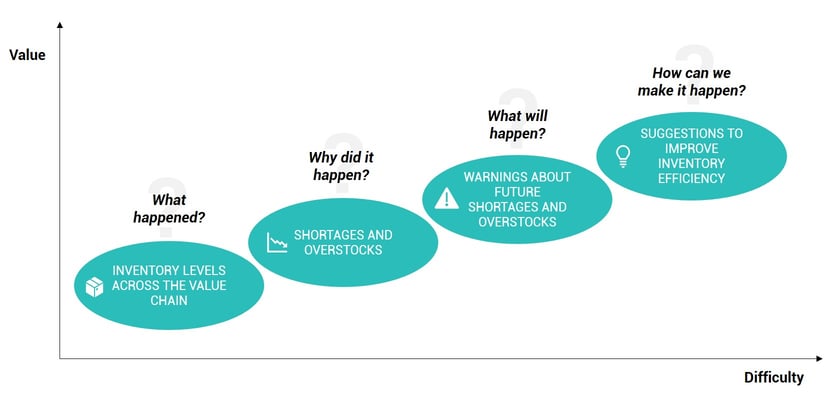Inventory should be a prime topic for all Supply Chain Directors who want to strengthen their analytics capabilities. That is because inventory is one of the most visible aspects of Supply Chain performance. And analytics can bring a lot of added value in many ways. By growing from descriptive analytics to prescriptive analytics, Supply Chains can collect benefits at every stage.
Inventory is a good pilot for analytics
Inventory is one of the most visible aspects of Supply Chain management. That is in large part because it is on every company's balance sheet. Chief Financial Officers keep an eye on inventory. But they are not alone. Vice-Presidents of sales have an interest in stock levels too. Many are interested, but most of the time, the Supply Chain Director is accountable. He needs to limit the working capital requirements, guarantee best-in-class customer service, and avoid write-offs and scrapping costs.
Managing inventories can seem a choice between inadequate high-level monitoring and cumbersome detailed analysis. But there are other ways. With a combination of targets and reports, planners can work only on the exceptions. In that way, they cover a broad area in depth but remain efficient. Analytics can help to reach that goal.
A step-by-step approach to prescriptive inventory analytics
To get the most out of inventory analytics, we recommend going one step at a time. In every step, people learn and get used to new techniques. And every new technique brings further gains that pay for the additional investment.
The descriptive step creates visibility on inventory levels across the supply chain. End-to-end reports show the position of the inventory in the supply chain. They can reveal how raw material, intermediate product, and finished goods stocks cover sales. People learn to think in value and not only in units. And they start to see how inventories on different levels add up to serve the same demand. The utility of descriptive analytics is that it combines information to make it quick and easy to consult. But it does not help the planners to find the items that require attention.
Diagnostic analytics helps to pinpoint shortages or overstocks and understand their causes. It assists planners to go straight to the stock-keeping units that need action. Is there more inventory than required? What can we do about it? How can we avoid it in the future? Are we short? Will that create a problem? Diagnostic inventory analysis will also encourage the management to look past total inventory value. By showing the quality of the inventory, it shows the difference between healthy and unhealthy stocks. To make this possible, the company needs detailed inventory targets, but those targets do not need to be precise. Simple techniques are usually sufficient to determine the proper minimum and maximum stocks.
Predictive analytics will warn about possible shortages and risks of slow-moving and obsolete stocks. By coupling data on inventories and demand, algorithms can alert planners if stocks risk passing their shelf life. They can create warnings if inventories reach critically low levels and lead to lost sales very soon. For these applications, analytics needs detailed inventory information (on a batch level, for example), reliable master data, and demand information. The logic becomes more complex, demanding more knowledge of the supply chain people. That is why it is better to start easy.
Prescriptive analytics can suggest actions to improve inventory efficiency. These actions should not simply be "launch a replenishment," of course. That kind of proposal should come from the planning system. Inventory analytics should suggest solutions that a basic planning system cannot, such as "move excess stock from location A to location B to reduce the risk of obsolescence." Prescriptive analytics can also look at the inventory parameters themselves. By analyzing inventory, supply, and demand data, it can propose changes to safety stocks, lot sizes, lead times, or other planning parameters.

Conclusion
With every step from descriptive to prescriptive analytics, new possibilities arise to improve inventory efficiency. New opportunities become visible. And supply chain people get more control over inventories without spending lots of time.




